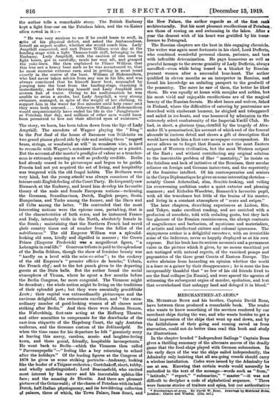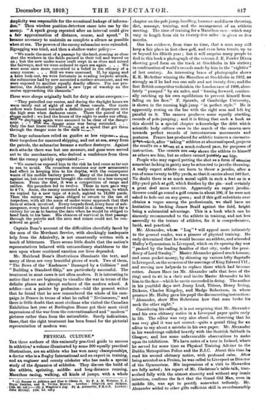MERCHANTMEN-AT-ARMS.* Ma. MuraREAD Boltz and his brother, Captain David Bone,
have between them produced a remarkable book. The reader who wants to know something of the services rendered by our merchant ships during the war, and who wants besides to get a visual impression of the ships that went up and down, and by the faithfulness of their going and coming saved us from starvation, could not do better than read this book and study its illustrations.
In the chapter headed " Independent Sailings " Captain Bone gives a thrilling summary of the alternate moves of the deadly game that the food-ships played with German submarines. In the early days of the war the ships sailed independently, the Admiralty only insisting that all sea-going vessels should carry a wireless installation. Codes were issued by the Admiralty for use at sea. Knowing that certain words would assuredly be embodied in the text of the message--words such as " from," `` latitude," " report," " submarine," " master "—it was not difficult to decipher a code of alphabetical sequence. " There were famous stories of traitors and spies, but our authoritative
dmplicity was responsible for the occasional leakage of informa gm" Then wireless position-detectors came into use by the enemy. " A spark group repeated after an interval could give fair approximation of distance, course, and speed." It became necessary to maintain as complete a silence as possible
when at sea. The powers of the enemy submarine were extended. Zigzagging was tried, and then a shallow-water policy:— "We made the most of a passage by the land, steering so close that the workers in the fields paused in their toil and waved us on ; but the new under-water craft crept in as close and mined the fairways, and we were ordered to open sea again. . . . We were soon once more converted to a belief in the efficacy of a crazy course.. . . Still we were unarmed. If, by zigzag and a keen look-out, we were fortunate in evading torpedo attack, the submarine had by now mounted a surface armament, and we were exposed to another equally deadly offence. For our protection, the Admiralty placed a new type of warship on the routes approaching the channels."
Fhese were sloops originally built for duty as mine-sweepers :—
" They patrolled our routes, and during the daylight hours we were rarely out of sight of one of these vessels. Our route orders were framed towards a definite point of departure into the high seas when darkness came. There the patrol of the tao9,,ps ended : we had the hours of the night to make our offing, ens*.^b sh112neak again were assumed to be clear of the danger zone. . . mae 14.■••4.nmr zone was being extended. . . .
Only the fast liners co
uld 37:1,-&-4 out at a speed that got them
through the danger zone in the darit The large submarines relied on gunfire as less expeasta man their torpedoes for unarmed shipping, and out at sea, away from
the patrols, the submarine became a surface destroyer. Against such attacks there was but one measure, and guns were served out to the merchantmen, who derived a confidence from them that the enemy quickly appreciated:— "We ourselves exposed him to the risk he had come so far out to sea to avoid. On countless occasions our new armaments bad effect in keeping him to his depths, with the consequent waste of his mobile battery power. Many of the hazards were against us, but our weapons brought the contest to a less unequal balance. From the first, it was a competition of range and calibre. Six-pounders led to twelve. These in turn gave way to 4-7's. Anon, the enemy mounted a heavier weapon, to which we replied by a new type of 4-inch, sighted to 19,000 yards. Then the enemy was again obliged to return to the use of torpedoes, with all the maze of under-water approach that that form of attack involved. Every torpedo fired, every hour of submergence, every knot of speed extended in a chase, was so far a victory for us as to hasten the date when he would be obliged to head back to his base. His chances of survival in that passage through the patrols and the nets and mines could not be considered as good."
Captain Bone's account of the difficulties cheerfully faced by the men of the Merchant Service, with shockingly inadequate help from the Admiralty, is not unnaturally written with a
touch of bitterness. There seems little doubt that the nation's representatives behaved with extraordinary shabbiness to the men upon whose continual exertion our lives depended.
Mr. Muirhead Bone's illustrations illuminate the text, and many of them are very beautiful pieces of work. Two of them, " The Bows of the Kashmere Damaged by a Collision " and " Building a Standard Ship," are particularly successful. The treatment in most cases is not ultra-modern. It is interesting to notice that we are beginning to visualize the war in terms of the definite planes and abrupt surfaces of the modern school. A soldier—not a painter by profession—told the present writer that he found that he now remembered the whole of his campaign in France in terms of what he called " Nevinsonese," and there is little doubt that most civilians who visited the Canadian Exhibition last year at Burlington House got their most vivid impressions of the war from the conventionalized and " modern " pictures rather than from the naturalistic. Surely indications, these, that the right treatment has been found for the pictorial representation of modern war.



















































 Previous page
Previous page